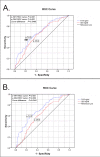Increased serum levels of tumour-associated trypsin inhibitor independently predict a poor prognosis in colorectal cancer patients
- PMID: 20849596
- PMCID: PMC2946315
- DOI: 10.1186/1471-2407-10-498
Increased serum levels of tumour-associated trypsin inhibitor independently predict a poor prognosis in colorectal cancer patients
Abstract
Background: There is an insufficient number of reliable prognostic and response predictive biomarkers in colorectal cancer (CRC) management. In a previous study, we found that high tumour tissue expression of tumour-associated trypsin inhibitor (TATI) correlated with liver metastasis and an impaired prognosis in CRC. The aim of this study was to investigate the prognostic validity of serum TATI (s-TATI) in CRC. We further assessed the prognostic value of carcino-embryonic antigen in serum (s-CEA) and the interrelationship between s-TATI and TATI in tissue (t-TATI).
Methods: Using an immunofluorometric assay, s-TATI levels were analysed in 334 preoperatively collected serum samples from patients with CRC. Spearman's Rho and Chi-square test were used for analysis of correlations between s-TATI and clinicopathological parameters, s-CEA and t-TATI. Kaplan-Meier analysis and Cox uni- and multivariate regression analysis were used to estimate disease free survival (DFS) and overall survival (OS) according to quartiles of s-TATI and cut-offs derived from ROC-analysis of s-TATI and s-CEA.
Results: Increased levels of s-TATI were associated with a reduced DFS (HR = 2.00; 95% CI 1.40-2.84, P < 0.001) and OS (HR = 2.40; 95% CI 1.74-3.33, P < 0.001). (HR = 2.89; 95% CI 1.96-4.25). This association remained significant in multivariate analysis. The association for OS remained significant in multivariate analysis (HR = 1.51; 95% CI 1.03-2.22, P = 0.034 for DFS and HR = 1.78; 95% CI 1.25-2.53, P = 0.001 for OS). There was no significant association between s-TATI and t-TATI. The prognostic value of s-CEA was also evident, but somewhat weaker than for s-TATI.
Conclusions: High preoperative s-TATI levels predict a poor prognosis in patients with CRC, and the prognostic value is independent of established prognostic parameters and t-TATI expression. These data suggest that s-TATI might be a useful marker for prognostic stratification in CRC.
Figures




Similar articles
-
Effects of radiation therapy on tissue and serum concentrations of tumour associated trypsin inhibitor and their prognostic significance in rectal cancer patients.Radiat Oncol. 2011 Aug 24;6:100. doi: 10.1186/1748-717X-6-100. Radiat Oncol. 2011. PMID: 21864386 Free PMC article.
-
Postoperative CEA is a better prognostic marker than CA19-9, hCGβ or TATI after resection of colorectal liver metastases.Tumour Biol. 2018 Jan;40(1):1010428317752944. doi: 10.1177/1010428317752944. Tumour Biol. 2018. PMID: 29378497
-
Tumor-associated trypsin inhibitor (TATI) in patients with colorectal carcinoma. A critical comparison with CEA.Scand J Clin Lab Invest Suppl. 1991;207:43-6. doi: 10.3109/00365519109104625. Scand J Clin Lab Invest Suppl. 1991. PMID: 1780689
-
Diagnostic and Prognostic Value of Serum Interleukin-6 in Colorectal Cancer.Medicine (Baltimore). 2016 Jan;95(2):e2502. doi: 10.1097/MD.0000000000002502. Medicine (Baltimore). 2016. PMID: 26765465 Free PMC article. Review.
-
Molecular mechanisms of tumour budding and its association with microenvironment in colorectal cancer.Clin Sci (Lond). 2022 Apr 29;136(8):521-535. doi: 10.1042/CS20210886. Clin Sci (Lond). 2022. PMID: 35445707 Review.
Cited by
-
Role of the tumor-associated trypsin inhibitor SPINK1 in cancer development.Asian J Androl. 2011 Jul;13(4):628-9. doi: 10.1038/aja.2011.45. Epub 2011 May 23. Asian J Androl. 2011. PMID: 21602832 Free PMC article. No abstract available.
-
Cbl-b accelerates trypsin-induced cell detachment through ubiquitination and degradation of proline-rich tyrosine kinase 2.Tumour Biol. 2014 Nov;35(11):11129-35. doi: 10.1007/s13277-014-2296-z. Epub 2014 Aug 7. Tumour Biol. 2014. PMID: 25099615
-
Serine Protease Inhibitor Kazal Type 1 (SPINK1) Promotes Proliferation of Colorectal Cancer Through the Epidermal Growth Factor as a Prognostic Marker.Pathol Oncol Res. 2015 Sep;21(4):1201-8. doi: 10.1007/s12253-015-9949-0. Epub 2015 Jun 3. Pathol Oncol Res. 2015. PMID: 26037168
-
Role of the inflammatory protein serine protease inhibitor Kazal in preventing cytolytic granule granzyme A-mediated apoptosis.Immunology. 2011 Dec;134(4):398-408. doi: 10.1111/j.1365-2567.2011.03498.x. Immunology. 2011. PMID: 22043941 Free PMC article.
-
Elevated expression of MGb2-Ag/TRAK1 is correlated with poor prognosis in patients with colorectal cancer.Int J Colorectal Dis. 2011 Nov;26(11):1397-404. doi: 10.1007/s00384-011-1237-1. Epub 2011 May 15. Int J Colorectal Dis. 2011. PMID: 21573901
References
-
- Gaber A, Johansson M, Stenman UH, Hotakainen K, Ponten F, Glimelius B, Bjartell A, Jirstrom K, Birgisson H. High expression of tumour-associated trypsin inhibitor correlates with liver metastasis and poor prognosis in colorectal cancer. British journal of cancer. 2009;100(10):1540–1548. doi: 10.1038/sj.bjc.6605047. - DOI - PMC - PubMed
-
- Gouyer V, Fontaine D, Dumont P, de Wever O, Fontayne-Devaud H, Leteurtre E, Truant S, Delacour D, Drobecq H, Kerckaert JP. et al.Autocrine induction of invasion and metastasis by tumor-associated trypsin inhibitor in human colon cancer cells. Oncogene. 2008;27(29):4024–4033. doi: 10.1038/onc.2008.42. - DOI - PubMed
Publication types
MeSH terms
Substances
LinkOut - more resources
Full Text Sources
Medical

